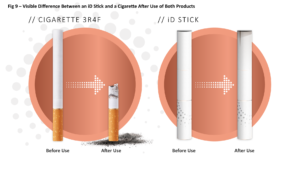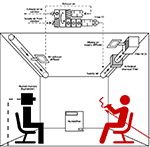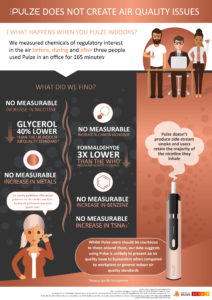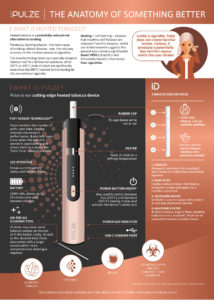//How does exhaled heated tobacco aerosol behave in the air?
Posted 14/07/2021 10:10am
Considerable research informs the dynamics of exhaled e-cigarette aerosols, but how much do we know about the same processes for heated tobacco? Liz Mason picks over the particles.
The premise of heated tobacco (HT) is simple: tobacco leaf is heated, never burnt, so avoiding many harmful by-products of combustion for the user. The exhaled ‘mist’ is correctly termed an aerosol, which is almost invisible and far less dense and pungent than the exhaled smoke from combustible cigarettes.

Heat-not-burn: Heated tobacco does not combust like a cigarette. Image: Imperial Brands
Another advantage of HT is that there are no ‘side-stream’ emissions to impact air quality (or disturb bystanders – these emissions form part of the ambient smoke that’s often known as environmental tobacco smoke (ETS) or ‘second-hand’ smoke), because unlike a combustible cigarette there is no constantly burning tip. Our previous research suggests that, unlike cigarettes, using our Pulze heated tobacco device causes no discernable negative impact on indoor air quality (IAQ).
As the HT category grows in popularity as a potentially less harmful alternative to combustible cigarettes amongst adult smokers, there will likely be a desire for more information about how exhaled HT aerosol behaves around both users and bystanders. For these reasons we commissioned an independent research study undertaken by leading EU air quality researchers at the Kaunas University of Technology, Lithuania, to find out how our HT device Pulze’s exhaled aerosol behaves in terms of spatial and temporal dynamics compared to combustible cigarette smoke.
The results, published in the peer-reviewed journal Aerosol and Air Quality Research, demonstrate:
- Particles exhaled following use of the HT product are droplets comprised of 75-85% water and evaporate quickly, disappearing 10 seconds after a puff
- By contrast, particles from conventional cigarettes are mainly non- or semi-volatile particles that are much more stable than those from HT: the removal of these particles takes much longer (30-45 minutes)
- The average particle size was 93nm for HT and 165-200nm for CC
- Distance between HT users and bystanders was shown to be the most significant factor affecting aerosol dynamics that influences short-term bystander exposure
- While ventilation intensity and relative humidity didn’t have statistically significant effects on aerosol particle behaviour, longer-term exposure should take into consideration both ventilation intensity and distance between HT users and bystanders
- The aerosols exhaled following use of Pulze’s ‘standard’ (345°C) and ‘eco’ (315°C) modes were both tested, but no significant difference in aerosol concentration and particle size distribution was recorded
Overall, the results demonstrate the exhaled aerosol produced using Pulze is very different in terms of chemical composition and spatial and temporal dynamics, and does not impact IAQ in the same way as cigarette smoke. This further validates the air quality and broader potential tobacco harm reduction credentials of the HT category compared to combustible cigarette smoke.
Testing, testing…
How was this research conducted? Study lead Professor Dainius Martuzevicius from the Department of Environmental Technology, Kaunas University of Technology, Lithuania, explains:

Diagram of experiment showing detection equipment (left) and the subject smoking/using HT device (right). Image: from Meišutovič-Akhtarieva et al., Creative Commons (CC BY 4.0)
“To measure particle dynamics in controlled conditions, an indoor test chamber representing a standard room was used (see diagram), with 13m2 of floor area and a total volume of 35.8m3. A dummy bystander with a sampling inlet to replicate breathing was used to record the air and particle number concentration (PNC) and particle size distribution (PSD). These were measured by a Fast Mobility Particle Sizer (FMPS) spectrometer. Four-way mixing ventilation was chosen for this study because it is commonly used in residential buildings.”
To conduct the experiments, either a Pulze HT device with accompanying tobacco consumable iD stick or combustible cigarettes were used by volunteers standing 0.5, 1m or 2m from the dummy bystander, with a total of 108 runs made to collate data.
The results showed that, as expected, the further the bystander was from the active user, the lower the detected PNC. If the user is closer to the bystander, then the exhaled aerosol does not have sufficient time to disperse into the surrounding air. As the distance increases, the exhaled aerosol can still be registered, but at much lower levels.

Click to enlarge: previous research demonstrates Pulze does not create indoor air quality (IAQ) issues. Image: Imperial Brands
At 0.5m, the HT aerosol number concentration during puffs reached 1.6 million particles per cm3, compared to 147 million per cm3 for CC. After five seconds the puff concentration dropped to 1000-10,000 particles per cm3, which is comparable to the particle number concentrations in many urban environments.
At 1m and 2m the effect of a puff is significantly diminished because the aerosol is diluted and dispersed as it moves around the room. At 2m, only a very directional puff towards the bystander elevates the aerosol concentration.
HT and vaping have no discernable negative impact on IAQ as measured using national and international IAQ guidelines. This is in contrast to combustible cigarettes, use of waterpipes, as well as many other indoor pollution sources, including incense burning and mosquito coils (see Table 2).
Dynamic changes
Science shows that HT indoor aerosol particle dynamics are fundamentally different from cigarette smoke. The HT exhaled aerosol is mostly composed of water droplets, and as such they do not linger as long in the air, and so do not exceed IAQ standards and guidelines, especially when compared to cigarette smoke.
This is positive news, and confirms findings by other researchers that have shown toxicant levels in exhaled HT aerosol are significantly lower than in cigarettes, with levels of some exhaled compounds indistinguishable from normal background levels, if detectable at all.
Overall, our scientific substantiation to date indicates that indoor Pulze use is unlikely to present an indoor air quality issue or risk to bystanders, especially compared to existing background levels of toxicants, indoor air quality standards and pollutants in urban areas.
“These results further confirm that use of HT products should be permitted in indoor spaces, but users should be courteous to those around them,” adds Dr Grant O’Connell, Head of Tobacco Harm Reduction Science at Imperial Brands. “The findings also add to the body of evidence that heated tobacco products have an important part to play in making a meaningful contribution to potential tobacco harm reduction.”
Read the full article here, which also contains data about e-cigarette aerosol.
[ENDS]
—
You are free to share this content with credit to Imperial Brands under a Attribution-NoDerivatives 4.0 International (CC BY-ND 4.0) license.


